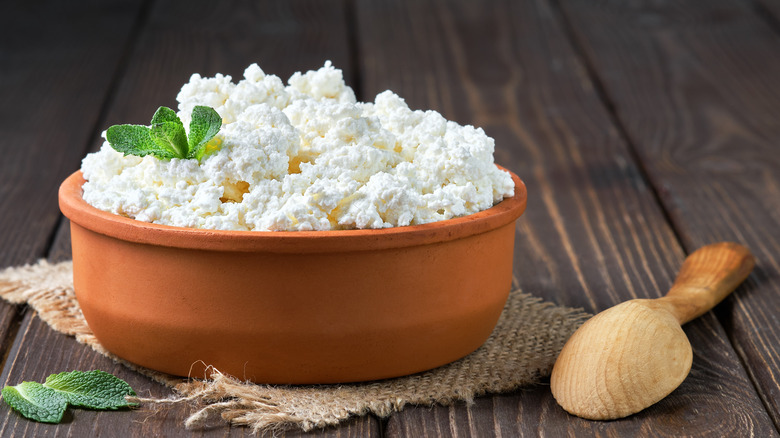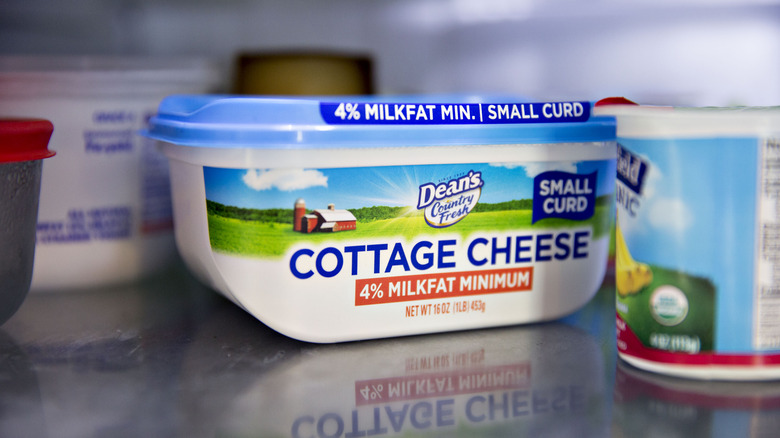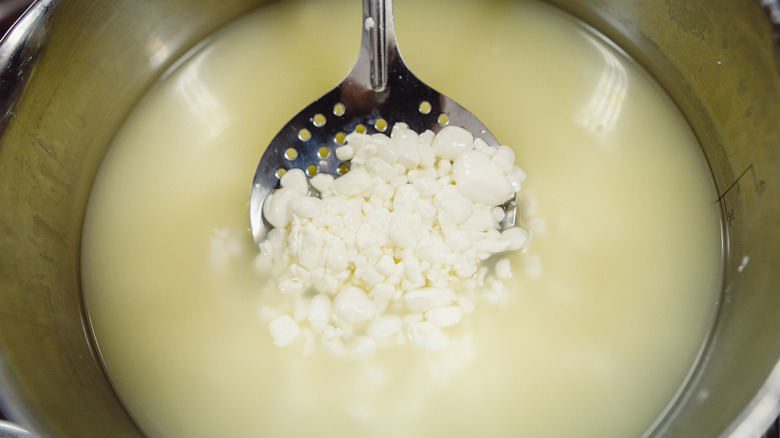The Science Behind Why Cottage Cheese Can Be So Inconsistent
Humans have been using cottage cheese in a variety of ways for at least 5000 years. From that information alone, if you didn't know any better you'd be forgiven for thinking two things: It must be popular to have stood the test of time, and humans have probably nailed a process to make this pretty consistent by now. Unfortunately, neither is really true. Cottage cheese makes regular appearances on 'most hated foods' lists; it owes its popularity more to it being easy and fast to make, even with only basic equipment and ingredients. As for consistency, cottage cheese is a product that is famously inconsistent. Even two identical pots of cottage cheese from the same brand can have substantial differences in flavor, texture, and appearance.
So why so many inconsistencies from pot to pot? There's no simple answer to this question. For a start, what exactly is it that's so inconsistent about cottage cheese? Many people have claimed to experience numerous inconsistencies including sourness, strength of flavor, texture, curd size, maturity, and liquid quantity. Part of the reason there are so many inconsistencies in cottage cheese lies in the surprising amount of variables that impact the final product. However, most of these inconsistencies can be put down to one of three factors: cheesemaker preferences during production, additives and flavorings, and incorrect storage. Let's take a look at the science behind each of these factors more closely.
How to get the best from cottage cheese
One key factor for variation is deterioration over time. Cottage cheese can last up to three weeks if stored correctly at around 40 F, but this doesn't always happen. The cold chain can be broken during transportation from cheesemaker to store, and from there to your home. One study found that an increase of 4 F has been shown to decrease the shelf life of cottage cheese by a whopping 63%, while also increasing the amount of liquid whey that is released from the curds. Whey contains a substantial amount of lactose (about 5%), and this can continue to convert to lactic acid which leads to an increased sourness in your cottage cheese. This is what happens when you see cottage cheese that has a lot of watery liquid surrounding the curd chunks.
There's not much you can do to ensure your cottage cheese has been kept at the ideal 40 F before you buy it, but you can control the temperature it stays at after purchase, so try to return it to your fridge in a sealed container as soon as possible after using it. Also, cottage cheese is sold in differing fat percentages varying from fat-free to high-fat (over 5%). Higher-fat cottage cheeses will be substantially creamier, so if this is what you're accustomed to, you may notice any liquid whey release more as it will change the consistency of the surrounding liquid from creamy to watery.
Cottage cheese production and inconsistencies in the final product
To produce cottage cheese, a cheesemaker will go through a multi-stage process, each stage of which contains variables. Fermenting can be done with an acid or a culture, and the choice of which will impact the final result. During fermentation, the lactose in the milk converts into lactic acid, which separates the milk into curds (the hard bits) and whey (the liquid). The curds are drained and the whey is cut according to the manufacturer's preference, which of course will impact the final product. Also, commercial cottage cheese is cut in large vats with a knife cutting criss-cross patterns in giant slabs of milk curd. This process isn't precise: Pieces of curd rub and break as the knife passes through, so it's no surprise there's chunk size variation in most commercial cottage cheese. Once cut, the whey liquid is drained off, then the curds are sometimes rinsed to wash off lactic acid-containing whey residue. Rinsing reduces the acidity of the curds, also impacting the sourness of the end product, as does the number of rinses.
The final stage of production is flavoring and creaming, in which cream (or an alternative such as buttermilk) is added to the curds along with salt and any other preservatives and flavorings. The choice of what is included here and how much has a huge impact on the taste of the cottage cheese, especially on its creaminess.


